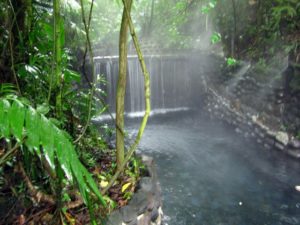While visiting the very vibrant and biologically diverse country of Costa Rica, our study abroad group was able to witness the culture and work ethic present in the country. Throughout our trip, we discovered that most of the communities were representations of familial collectivism. According to the Geert Hofstede Cultural Dimensions, Costa Rica on average, scores a low 15 out of 100 in individualism because Ticos (Costa Ricans), especially rural citizens, tend to be very involved in their communities. Most strive to help and serve one another whenever or wherever needed to build stronger and thriving interpersonal bonds. However, the idea of individualism – the belief that the needs of each person is more important than the needs of society as a whole – could be witnessed in one business we visited on our trip: Hot Springs Tourism.

At the foot of the still active Arenal Volcano. Thanks to its geothermal activity, there are a number of natural Hot Springs in the area.
On our eighth day abroad, we drove through the city of La Fortuna. On a small road, staring out of our van’s window, we could see a man bathing in the lake below us. Later that same day, driving back on the same road, where one man was bathing earlier, 20 more now congregated in the same spring, floating and soaking under the trees. These are the Hot Springs of La Fortuna, naturally heated by the Arenal Volcano.
In the early 70s, before commercialization or tourism in Costa Rica became abundant, land was used to graze livestock until wealthy foreigners bought the land. Over time, these owners realized the earth surrounding the volcano was insufficient for plant growth. So eventually, the owners sold the land to new owners who saw the damage caused by overgrazing and bad soil. The new owners took the initiative to repair the soil and plant new crops. While doing so, they discovered the now famous hot springs. They further developed the already naturally formed “pools” and advertised both their beauty and comforts. The combination of both helped satiate the land owner’s want for economic profit by appealing to tourists and locals, while also allowing growth and reforestation for the surrounding rainforest reserves.
Even more specific to the individualist ideal in the hot springs industry, the Tabacon Hot Springs and Spa has quite the history. The first hot spring attraction in Costa Rica was Tabacon. The original owners of Tabacon were Costa Rican. The pools were readily available for locals who wanted a casual dip in the relaxing and medicinal waters. However, as time passed and the economy changed, the owners were forced to sell, and a Colombian foreigner bought Tabacon and increased entry prices, especially for foreigners visiting during their vacations. These price fluctuations still apply today. A local Tico may pay 9,000 Colones (about $18 USD) to enter, while a foreigner (an American for example) may pay anywhere from $30-$40 per visit.
At one time, to further promote profit and privacy, Tabacon owners cut off public access to the hot springs by building a wall in the river to keep out local residents from entering the springs for free. Legally, however, all rivers and lakes, except those sections located on private property, belong to the public and its counties. In response, the locals tore the wall down. In retaliation, Tabacon owners planted grass and obstructing plants in the open areas surrounding the springs so non-payers were unable to park their cars. But once again, that has not stopped the Ticos and their “PURA VIDA” mentality. Nowadays, most just park on the side of the road facing the springs and take a dip whenever they like. As they say in Costa Rica, “the land belongs to the people.”
